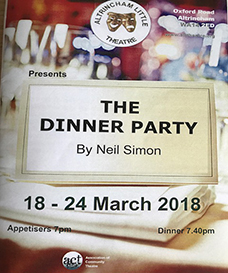Association of Community Theatre

THE DINNER PARTY
by Neil Simon
directed by John Chidgey
Altrincham Little Theatre

A dinner party has been arranged in a Parisian restaurant. The set that had been created and designed by Polina Sparks, Alan Reidsma and Steve Smith certainly created the artistic space that reflected this, and it was very much appreciated by the audience. The use of red, gold and orange colours created an ambience of a high quality restaurant. The lighting, on stage lights and the furniture, helped establish this. There were more than enough doors through which characters could disappear at the right times as the plot unfolds so that certain characters do not meet until the plot takes a twist. As the curtain opened there were gasps and the play began with a round of applause.
At the start of we are introduced to the first two dinner guests Albert (Steve Cunio) and Albert (John Westbrook) who are rather confused as to the reason why they are there. They are soon joined by a third person, André (Arthur Hulse) who does seem to have an idea of what is going on. This trio soon have their former wives join them: Mariette (Emily Duffy), Yvonne (Christine Perry) and Gabrielle (Kathryn Fennell). This is where the play became serious as they were required to reflect on their relationships and to expose the best, and worst, times of their marriages to each other.
This was not a farce I was expecting. Farces usually start slowly, to introduce the audience to each character, and then pick up speed to reach a conclusion. Though there were elements of farce employed such as characters exiting through doors to avoid seeing their respective ex partners, I felt that the dialogue didn’t gather pace to move the plot along during the first half before, quite rightly, slowing at the end as each character reflected on his or her relationship.
Steven Cunio was confident with his dialogue when telling of his sordid divorce. John Westbrook spoke of his painful divorce. He employed some great slap-stick moments to engage the audience such as choking on a canapé when Mariette entered, and squeezing out his handkerchief after mopping up some spilt drink. I had to chortle to myself when he kept disappearing through one of the doors to a bathroom because he had a “smudge on my face” – and I wasn’t alone. Arthur Hulse was the more exasperated ex-husband who gave the impression that he didn’t suffer fools gladly and was a little intolerant of people and situations in which he had no interest.
The ex-wives were reminiscent of the three characters in, “Witches of Eastwick”. Each was a different characterisation. Emily Duffy was the writer, Mariette, whose line delivery and tone spoke volumes and helped express her emotions as a “claustrophobic wife”. Christine Perry was earnest in character, which was a great counterpoint to the characters we had met previously. She created a lovable character who had some lovely dialogue to deliver such as, “Marriage is like a window. There is something out there but you could never see what”. Kathryn Fennell created Gabrielle, who was the final partner introduced to the audience. As a “dead” wife, this character had been well thought out, who, metaphorically speaking, described her marriage to André as “crashing around like two bats in a cave”. Yet there was a yearning for them to rekindle their passion. This came across quite plainly.
There was a great symbolic moment at the end as characters left the room but all returned to share dinner together except André. The play ends as Gabrielle says they will leave the door open because of Mariette’s claustrophobia, but the audience knew it was really that she hopes her ex-husband will also return.
Thank you for an entertaining and thought provoking evening’s entertainment.